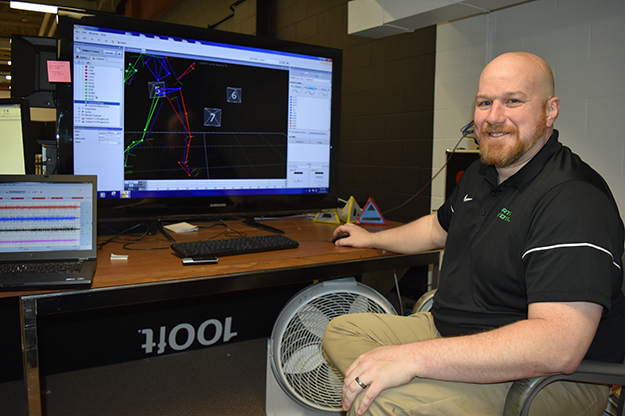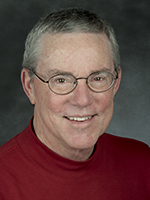Capturing the moment
UND grad student, Kinesiology Department use Hollywood-esque technology to design better spacesuit

Using technology worthy of a high-tech Hollywood movie, Space Studies graduate student Sophie Orr is studying how to prevent motion-related injury in astronauts working in space.
Orr partnered in her research with Jesse Rhoades, a UND faculty member in Kinesiology and expert in the use of motion-capture technology—the very kind that Hollywood directors use to craft movies such as James Cameron’s Avatar and Marvel’s critically acclaimed The Avengers, among many others.
Motion capture — also known as performance capture or motion tracking — is a visually arresting technology in the movies. But for scientists like Rhoades and students like Orr, it’s a powerful research tool.
Rhoades — with a master’s degree in biomechanics from Indiana State and a Ph.D. from the University of Illinois in pedagogical kinesiology — teaches undergraduate physical education at UND.
He jumped at the chance to help Orr, who wanted to tap into his motion capture expertise to understand how astronauts maneuver around in their heavy suits.
“I’m looking at the human gait in the lunar and Martian environment, especially how that gait changes,” said Orr. “When humans were just visiting the Moon for short periods, mission scientists weren’t that worried back then about locomotion-related repetitive stress injury.”
Now with longterm space travel a fast approaching, there’s a real concern about astronaut safety resulting from long periods of movement on planetary surfaces.
“We’re looking at gait transitions in bipedal locomotion and the damage done to muscles when going from walking to running,” Orr said. “This involves kinesiology, biomechanics, and space studies.”
Gravity machine
The 3D-motion capture expertise that Rhoades developed is instrumental in advancing Orr’s research.
Part of the process involves computerized stick figures that enable the team to extract information about how a person moves and how center of mass moves in relation to the subject’s body. Orr and Rhoades closely examine the process from different angles and focus on different joints, comparing how they might move in, say, lunar gravity.
This will help Orr and other researchers in the field understand how to build space and planetary exploration suits of the future to reduce locomotion-related injuries.
“The objective of my project is to see if some type of pathology might form depending on the type of locomotion in fractional gravity (planetary exploration) and then to train astronauts so they don’t injure themselves,” Orr said. “Remember the astronauts skipping on the Moon—that may not be best way to get around.”
The overall goal: “We’re looking to determine the best way to train astronauts so they don’t injure themselves and to design more efficient suits.
Orr teamed up with Rhoades on a research mission to ARGOS, the Active Response Gravity Off-load System, at NASA’s Johnson Space Center.
“That’s a giant machine 20-feet tall that simulates different gravitational forces such as on the surface of the Moon or Mars,” Rhoades said. “A person jumps and a pneumatic system in the machine slowly returns the subject to the ground at the same speed as it would be on the Moon or Mars.”
Orr’s project is funded by many entities, starting with an agreement with Johnson Space Center that facilitates the use of ARGOS at no direct expense. Additionally, NASA-funded North Dakota Space Grant Consortium, based at UND Aerospace, helped out with man hours and cash, and gave her a fellowship to work on this for two semesters. Space Grant also paid for the trip to do the ARGOS study. The Department of Space Studies, the Physical Therapy and the Kinesiology departments also contributed time and effort.

Great exposure
UND Space Studies faculty member Pablo De Leon — a well-known expert on planetary suit systems design and fabrication — is Orr’s advisor and chairs her dissertation committee, which also includes Rhoades as the outside reader.
“Dr. Rhoades helped me to make sure the equipment and cameras were set up correctly so that I obtain clean data, especially on muscle activation,” said Orr, who originally is from Palo Alto, Calif., and got her undergrad degree in anthropology from the University of California, Davis.
For Rhoades, Orr’s research is helpful in facilitating his own teaching expertise in kinesiology.
“My whole idea is to expand out to other departments using technology, such as motion capture, with folks who don’t normally use it,” Rhoades said.
Rhoades noted that his biomechanical and motion-capture lab and equipment was funded, in part, by student technology fees, specifically, a College of Education & Human Development (EHD) technology committee award.
“The BiPed lab facilitates motion capture experiences within our biomechanics courses, as well as many graduate experiences,” Rhoades said. “This has been the primary part of our outreach. Most of the utilization of this equipment either supports graduate student research or undergraduate learning.”
“At this point, we have been able to use this equipment for outreach graduate work in two colleges in addition to EHD: the John D. Odegard School of Aerospace Sciences and the School of Medicine & Health Sciences,” he said. “Overall, I think that this has been a big success in that it has allowed us to support student learning and research, and give great exposure for our college around the University.”
About the author
Juan Miguel Pedraza, is co-founder of STEMflash Media, which contracts with the UND Division of Research & Economic Development. With a multicultural background and fluency in six languages, Pedraza brings extensive experience in print and broadcast journalism; technical editing; and both public sector and private sector public relations, to his consultancy work with UND. Born in Spain and having spent part of his childhood in places such as Brazil, Pedraza received his bachelor’s degree in international studies from UND in 2008.


